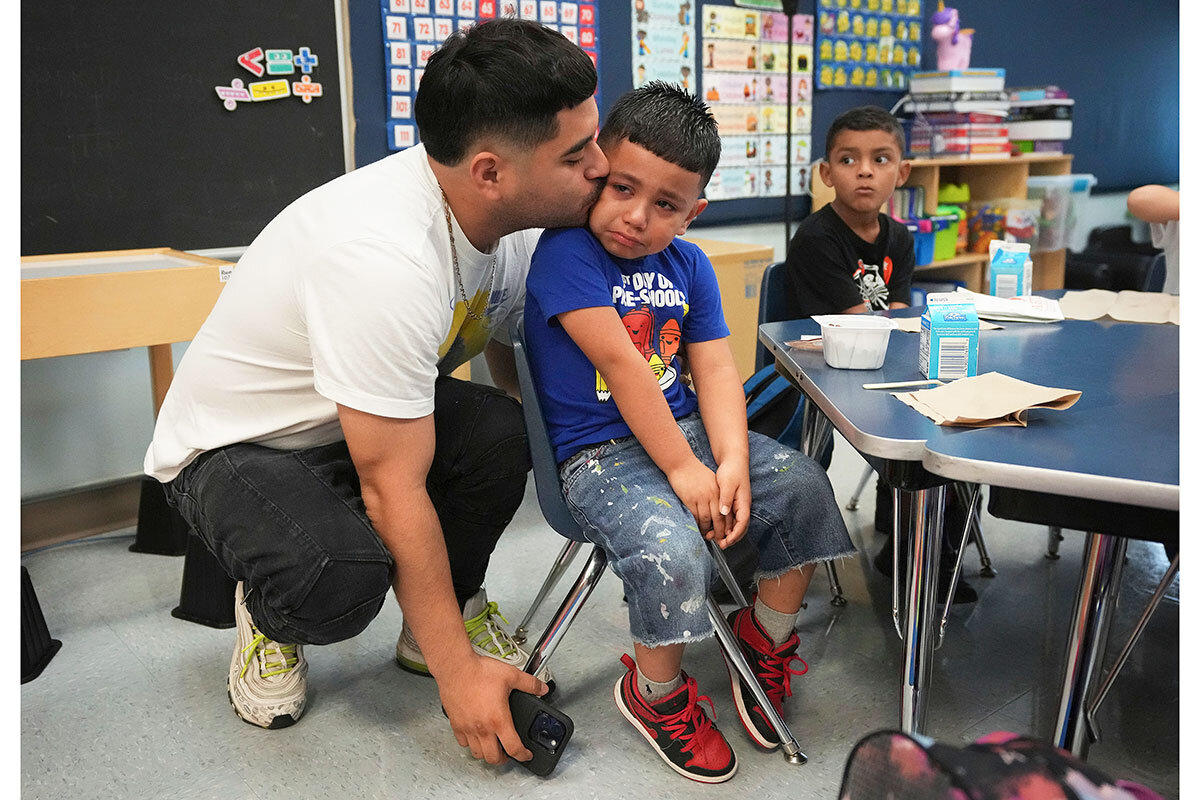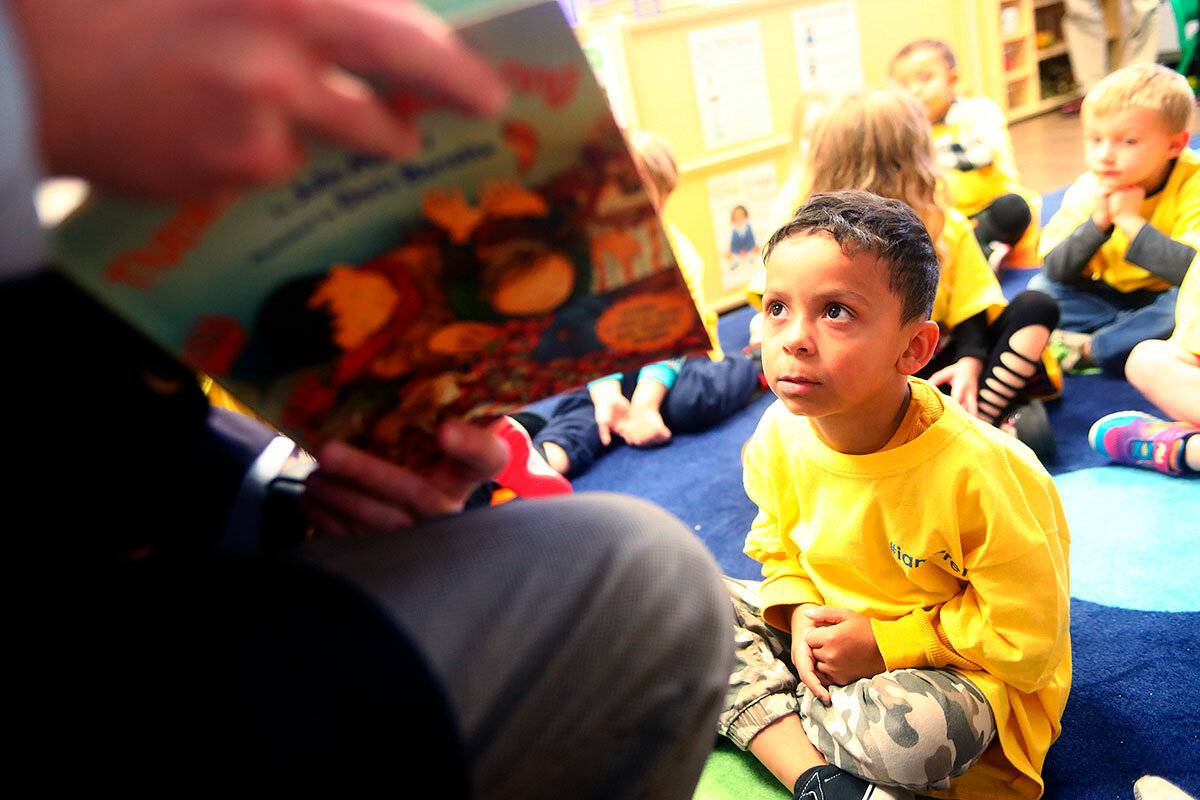Pre-K for all: What does it take to get every child an education?
Loading...
Thousands of 4-year-olds donning tiny backpacks and shy smiles will be entering classrooms this year courtesy of universal prekindergarten programs gaining steam – and funding – across the United States.
Pre-K is a milestone that child development experts say better prepares little learners for the next stages of school, and one that should be available to all children.
“They learn their letters. They learn their numbers. They learn how to be good friends. They learn how to share – those really important social-emotional pieces that set them up for success going forward,” says Danielle Ewen, a consultant for the Alliance for Early Success, which works with early childhood policy advocates at the state level.
Why We Wrote This
Getting all children schooling before kindergarten is generally accepted as a boon to both students’ learning and parents’ livelihood. But what’s the best way to do it? State rollouts are showing that making it work will take patience.
But launching a universal pre-K program – which, in theory, is free and accessible for all children in the eligible age group – isn’t as easy as A-B-C. States expanding access have been battling labor shortages, enrollment challenges, and, in at least one case, lawsuits.
Still, for every hiccup, there are grateful parents. Elizabeth Rexroad says she watched her 4-year-old son blossom into an inquisitive boy who started asking more questions, comparing and contrasting things, and making friends during prekindergarten last year.
She’s confident her son, now 5, is ready for kindergarten and beyond, thanks to his pre-K teacher’s special skill set.
“There are people that have spent their careers perfecting the craft of educating a 4-year-old,” says Ms. Rexroad, who lives in Bridgeport, West Virginia.
Many states have some form of state-funded prekindergarten, though it’s often limited to children who meet certain eligibility criteria. West Virginia was an early pioneer in providing universal prekindergarten – debuting its program in 2002, with full implementation a decade later. Since then, other U.S. states have either taken the plunge or inched their way toward offering the all-access program.
Progress has been sluggish in some of those states. But a fresh wave of expansion is underway following universal pre-K laws passed recently in California, Colorado, New Mexico, and Hawaii, according to the latest State of Preschool report from the National Institute for Early Education Research at Rutgers University. The governors of Michigan and New Jersey have also voiced support for increased funding to make universal pre-K possible.
The burst of activity comes despite the demise of President Joe Biden’s Build Back Better bill, which included federal funding for universal pre-K. That puts the onus back on states.
“Maybe the excitement and promise of that may have helped start this new wave, or, alternatively, it’s the same political force,” says Steve Barnett, founding director of the National Institute for Early Education Research.
Slowly growing
If an early adopter state like West Virginia is any indication, it can take years before pre-K is ingrained in the culture of the education landscape.
Melissa Sherfinski, an associate professor of early childhood and elementary education at West Virginia University, sees the learning curve even in her own collegiate-level classroom. She often finds that her students – many of whom were born and raised in the state – don’t know much, if anything, about the universal pre-K program.
“It’s like a generational thing where it’s slowly growing, and it will, I think, eventually take hold, as long as we can keep it,” she says.
The feedback she hears from parents who have sent their children to pre-K tends to be positive, though.
Ms. Rexroad is an example. Aside from the academic boost for her son, she says universal pre-K saved her family about $900 a month in child care, allowing her to go back to school and her husband to change jobs. They plan to send their daughter to pre-K when she’s eligible in a year.
“I cannot perceive any potential drawbacks,” she says.
Ups and downs in Colorado
Colorado leaders expect the state’s universal pre-K program, launching this year, will provide similar academic and economic benefits. The guaranteed free 15 hours per week of pre-K for 4-year-olds is projected to save Colorado families $6,000 yearly.
“Colorado is an expensive state to live in,” says Dawn Odean, director of the state’s universal preschool program. “And so this is one way that we can help support families economically as well as get to higher child outcomes.”
As of early August, Colorado had matched 39,849 children with a pre-K provider, representing 61% of all eligible 4-year-olds, according to a statement from Democratic Gov. Jared Polis’ office.
Four-year-olds from low-income households who have at least one other qualifying factor, such as a learning disability, are eligible for 30 hours of free pre-K per week. Three-year-olds with similar qualifying factors can also apply, though their acceptance depends on funding availability.
“The Governor is interested in expanding universal coverage to 18 hours ... for all children, while still providing full day coverage for all students who are low-income and have certain qualifying factors,” a spokesperson wrote in an email.
Colorado’s universal pre-K program – fueled by a new tax on electronic cigarettes and increased taxes on other tobacco products – is a mixed-delivery system. That means parents can choose to send their child to a pre-K program in a licensed community, home, or school setting.
Rebecca Gartman, executive director of Wings Early Childhood Center in Pagosa Springs, Colorado, expects to serve 10 4-year-olds this fall and more next year.
Some parents had trouble navigating the state’s application portal or didn’t understand how many hours of free pre-K their child was eligible to receive, she says. And from a provider perspective, Ms. Gartman says she worries the state could change its pre-K curriculum standards, affecting how the nature-based learning center operates.
Overall, though, she sees universal pre-K providing more opportunity for her southwest Colorado town, which is known for its hot springs but also has a large wage gap. Wings Early Childhood Center recently began an expansion project that will add preschool rooms.
“What we’re hoping is that we grow our child care facilities all through Pagosa and hope to bring in younger families moving in so that they can support our working community,” she says.
Perrine Monnet, a policy analyst with the Colorado-based Bell Policy Center, says universal pre-K addresses a need in a state where child care gobbles up nearly 30% of families’ median household income. Even so, she says, The Bell Policy Center, a nonprofit that supports policies that advocate for economic mobility, will be examining the enrollment data once it’s made available.
“In what parts of Colorado do we have a lot of extra [universal pre-K] seats? Where in Colorado are we seeing those get filled? And what’s the reasoning behind that?” she says.
The rollout of the program hasn’t been without its challenges, though. The state is already facing two lawsuits related to its universal pre-K program.
One was filed by several school districts that argue the structure prevents them from providing services to students with disabilities. The other comes from the , which operates a preschool program and had wanted to participate in the universal pre-K opportunity. But the lawsuit alleges the universal program’s nondiscrimination requirements – particularly pertaining to religious affiliation, sexual orientation, and gender identity – violate the church’s First Amendment rights.
“Invite parents in”
Farther west, California will be starting the second year of its transitional kindergarten (TK) program, which serves 4-year-olds. The program is gradually expanding based on children’s birthdates until it’s fully ramped up by the 2025-2026 school year. At that point, officials with Early Edge California, a nonprofit that advocated for the state’s TK program, expect it to serve more than 300,000 children.
Based on those projections, the Learning Policy Institute estimates California will need to hire upward of 15,600 lead TK teachers – a tall order in a tight labor market.
States expanding pre-K programs should consider ways to provide scholarships for aspiring pre-K teachers, who don’t always receive the respect or compensation they deserve, says Pamela Epley, vice president of academic affairs for the Erikson Institute, an independent graduate school for early childhood education.
“Some of those stigmas still remain, and, coupled with low pay, it’s hard to attract people into the field,” she says.
Early Edge leaders acknowledge that staffing TK has been a trouble spot in certain places, but in an email wrote that districts “can get creative in how they offer it if demand is low.”
But the recruitment challenge isn’t limited to the TK workforce. The Los Angeles Times that TK’s existence has spurred a recruitment race for the state’s prospective students. For some parents, it’s a choice between moving their child from another preschool provider to the free TK program, which is run by local public school districts. The school district can choose whether to offer full-day or half-day TK.
Patricia Lozano, executive director of Early Edge California, says spreading awareness about TK will be key as the state tries to reach more families – particularly those who don’t qualify for any subsidies for their children to attend other preschool programs, such as Head Start.
“California is trying to support parent choice as much as possible,” she says. “And I think it’s communication – just really letting parents know about it.”
Dr. Barnett says Rutgers’ early education institute is researching parent decision-making because underenrollment remains an issue in many places. In New Jersey, for instance, communities with similar demographics sometimes have very different pre-K enrollment trends, he says, signaling that barriers such as complicated sign-up processes or lack of transportation may exist.
“You have to invite parents in and design your programs so that they’re welcoming and culturally appropriate,” he says, adding that convenience is also key. “You either provide transportation, or there are ways for them to get their kids there.”
Dr. Epley of the Erikson Institute says she’s hopeful universal pre-K programs will live up to their definition by one day reaching all eligible children. But that will require more than just a new law.
“Saying it and having it is not the same thing as effectively implementing it,” she says.






